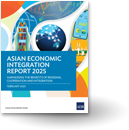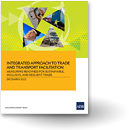- AEM December 2011
Economic growth in emerging East Asia will continue to moderate to 7.2% in 2012 from 7.5% in 2011—as growing sovereign debt problems in Europe and an anemic US economy raise the spectre of a deep global economic downturn, says the Asian Development Bank’s latest Asia Economic Monitor. In the event that both the eurozone and the US economies contract sharply, the impact on emerging East Asia would be serious yet manageable, the report says.
- AEM July 2011
After last year’s strong economic recovery, emerging East Asia will see growth moderate this year as authorities continue to battle inflation amid anemic recovery and deleveraging in advanced economies, says the July issue of the Asia Economic Monitor. ADB forecasts aggregate GDP to rise a still robust 7.9% in 2011 and 7.7% in 2012. The report says rising inflation could bring wage-price spirals that could upset the region's shift from crisis recovery to sustained economic growth. The July AEM also suggests that a pragmatic approach to a range of policies may help governments manage the inflationary impact of sustained and volatile changes in commodity prices.
- AEM December 2010
Governments and monetary authorities in emerging East Asia need to cooperate more on exchange rates and other policies to turn the swift post-crisis recovery into more balanced, long- term growth. The weaker outlook for the global economy coupled with the phasing out of fiscal and monetary stimulus within the region means economic growth should moderate next year following emerging Asia's robust recovery in 2010.
- AEM July 2010
With emerging East Asia’s V-shaped recovery on track, it is now time to unwind the policy stimulus that helped power the solid domestic demand that kept growth strong. The sustainability of the recovery will depend heavily on the timing, policy mix, and pace at which economic stimulus is withdrawn.
- AEM December 2009
Emerging East Asian economies have performed better than anticipated this year thanks to swift policy responses and an improved external environment, according to the December issue of the Asia Economic Monitor. GDP is now expected to grow 4.2% in 2009 and 6.8% in 2010.
- AEM July 2009
Emerging East Asia has entered the transition from recession to a possible V-shaped recovery, with growth dropping sharply this year before returning to 2008 levels next year. Fiscal stimulus is showing results, but authorities need to stay the course in supporting domestic demand and growth until recovery is firmly on track and external demand returns. The July AEM also examines the need for regulatory reform to promote financial stability within the region.
- AEM December 2008
- AEM July 2008
Aggregate GDP growth in emerging East Asia will moderate to a still solid 7.6% in 2008 and 2009 from the 9.0% peak in 2007, due to the global economic slowdown, high food and energy prices, and continued financial market volatility.
- AEM December 2007
Economic growth in emerging East Asia will ease to 8.0% in 2008 from 8.5% in 2007. Moderating growth in key industrialized nations and some softening in the People's Republic of China rapid expansion-- to 10.5% from this year's 11.4%-- are behind the outlook. Volatility in global financial markets and elevated oil prices are expected to continue. Slower regional growth, however, is being accompanied by rising inflationary pressures, despite continued appreciation of many of the region's currencies.
- AEM July 2007
The July AEM includes theme chapters on managing capital inflows in emerging East Asia and on the region's banking systems 10 years after the crisis. AEM says emerging East Asian economies will continue strong growth in 2007 and 2008.




